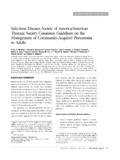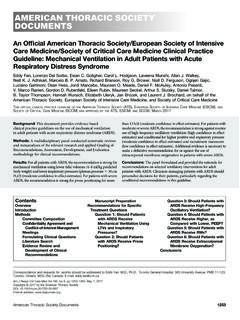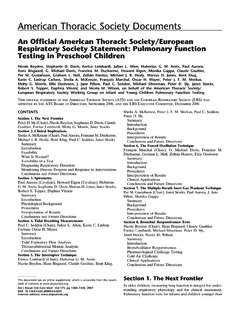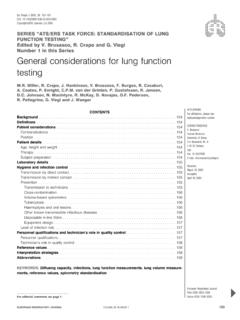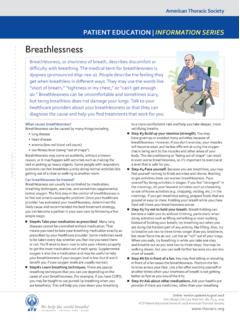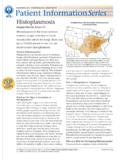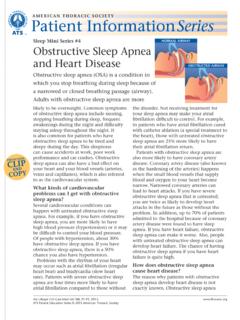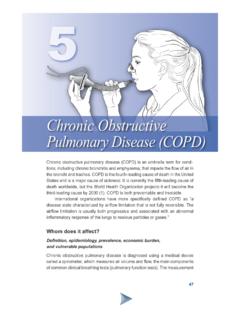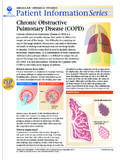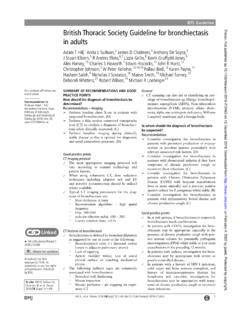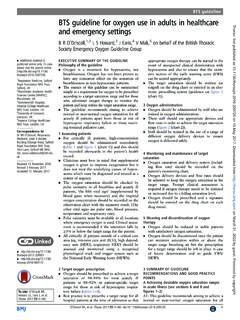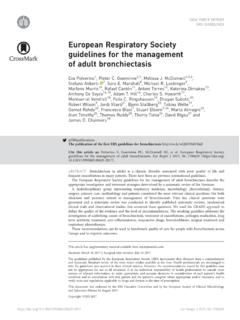Transcription of American Thoracic Society Documents
1 American Thoracic Society DocumentsAn Official ATS/IDSA Statement: Diagnosis,Treatment, and Prevention of NontuberculousMycobacterial DiseasesDavid E. Griffith, Timothy Aksamit, Barbara A. Brown-Elliott, Antonino Catanzaro, Charles Daley, Fred Gordin,Steven M. Holland, Robert Horsburgh, Gwen Huitt, Michael F. Iademarco, Michael Iseman, Kenneth Olivier,Stephen Ruoss, C. Fordham von Reyn, Richard J. Wallace, Jr., and Kevin Winthrop, on behalf of the ATSM ycobacterial Diseases SubcommitteeThis Official Statement of the American Thoracic Society (ATS) and the Infectious Diseases Society of America (IDSA)
2 Was adopted by the ATS Board Of Directors, September2006,and by the IDSA Board of Directors, January2007 CONTENTSS ummaryDiagnostic Criteria of Nontuberculous MycobacterialLung DiseaseKey Laboratory Features of NTMH ealth Care- and Hygiene-associatedDisease PreventionProphylaxis and Treatment of NTM DiseaseIntroductionMethodsTaxonomyEpidem iologyPathogenesisHost Defense and Immune DefectsPulmonary DiseaseBody MorphotypeTumor Necrosis Factor InhibitionLaboratory ProceduresCollection, Digestion, Decontamination, and Stainingof SpecimensRespiratory SpecimensBody Fluids, Abscesses, and TissuesBloodSpecimen ProcessingSmear MicroscopyCulture TechniquesIncubation of NTM CulturesNTM IdentificationAntimicrobial Susceptibility Testing for NTMM olecular Typing Methods of NTMC linical Presentations and Diagnostic CriteriaPulmonary DiseaseCystic FibrosisHypersensitivity-like DiseaseTransplant RecipientsDisseminated DiseaseLymphatic DiseaseSkin, Soft Tissue, and Bone DiseaseThis document has an online supplement, which is accessible from this issue stable of contents at J Respir Crit Care Med Vol 175.
3 Pp 367 416, 2007 DOI: address: Care and Hygiene-associated Disease and DiseasePreventionNTM Species: Clinical Aspects and Treatment GuidelinesM. aviumComplex (MAC) NTM Species/PathogensResearch Agenda for NTM DiseaseSummary of RecommendationsSUMMARYD iagnostic Criteria of Nontuberculous MycobacterialLung DiseaseThe minimum evaluation of a patient suspected of nontubercu-lous mycobacterial (NTM) lung disease should include the fol-lowing: (1) chest radiograph or, in the absence of cavitation,chest high-resolution computed tomography (HRCT) scan; (2)threeormoresputumspecimensforacid-fas tbacilli(AFB)analysis;and (3) exclusion of other disorders, such as tuberculosis (TB).
4 Clinical, radiographic, and microbiologic criteria are equally im-portant and all must be met to make a diagnosis of NTM lungdisease. The following criteria apply to symptomatic patientswithradiographicopacities,nodula rorcavitary,oranHRCT scanthat shows multifocal bronchiectasis with multiple small (MAC), , andM. notenough knownaboutmost other NTM to be certain that these diagnostic criteria areuniversally applicable for all NTM respiratory JOURNAL OF RESPIRATORY AND CRITICAL CARE MEDICINE VOL 175 Pulmonary symptoms, nodular or cavitary opacities onchest radiograph, or an HRCT scan that shows multifocalbronchiectasis with multiple small Appropriate exclusion of other Positivecultureresults fromatleasttwo separateexpecto-rated sputum samples.
5 (If the results from the initial spu-tum samples are nondiagnostic, consider repeat sputumAFB smears and cultures.)or2. Positive culture results from at least one bronchial washor Transbronchial or other lung biopsy with mycobacterialhistopathologic features (granulomatous inflammation orAFB) and positive culture for NTM or biopsy showingmycobacterialhistopathologicfeatu res(granulomatousin-flammationorAFB)ando neormoresputumorbronchialwashings that are culture positive for Expert consultation should be obtained when NTM arerecovered that are eitherinfrequently encountered or thatusually represent environmental Patients who are suspected of having NTM lung disease butwho do not meet the diagnostic criteria should be followeduntil the diagnosis is firmly established or Making the diagnosis of NTM lung disease does not,perse,necessitatetheinstitutionofthe rapy,whichisadecisionbasedonpotentialris ksandbenefitsoftherapyforindivid-ual Laboratory Features of NTM1.
6 The preferred staining procedure is the fluorochromemethod. Specimens should be cultured on both liquidand solid media. Species that require special growth con-ditions and/or lower incubation temperatures , , can cause cutaneous and lymph node In general, NTM should be identified to the species probes (MAC,M. kansasii, andM. gordonae) andhigh-performance liquid chromatography (HPLC). Forsome NTM isolates, especially rapidly growing mycobac-terial (RGM) isolates (M. fortuitum,M abscessus, andM. chelonae), other identification techniques may be nec-essary including extended antibioticin vitrosusceptibilitytesting, DNA sequencing or polymerase chain reaction(PCR) restriction endonuclease assay (PRA).
7 3. Routine susceptibility testing of MAC isolates is recom-mended for clarithromycin Routine susceptibility testing ofM. kansasiiisolates is rec-ommended for rifampin Routine susceptibility testing, for both taxonomic identifi-cation and treatment of RGM (M. fortuitum,M abscessus,andM. chelonae) should be with amikacin, imipenem( ),doxycycline,thefluorinatedquinolones,a sulfonamideor trimethoprim-sulfamethoxazole,cefoxitin, clarithromycin, linezolid, and tobramycin (M. chelonaeonly).Health Care and Hygiene-associated Disease PreventionPrevention of health care related NTM infections requires thatsurgical wounds, injection sites, and intravenous catheters notbeexposedtotapwaterortapwater in tap water and clinical specimens contaminated withtap water or ice are also not and Treatment of NTM Disease1.
8 Treatment of MAC pulmonary disease. For most patientswith nodular/bronchiectatic disease, a three-times-weeklyregimenofclarithromyci n(1,000mg)orazithromycin(500mg), rifampin (600 mg), and ethambutol (25 mg/kg) isrecommended. For patients with fibrocavitary MAC lungdisease or severe nodular/bronchiectatic disease, a dailyregimenofclarithromycin(500 1,000mg)orazithromycin(250 mg), rifampin (600 mg) or rifabutin (150 300 mg),and ethambutol (15 mg/kg) with consideration of three-times-weekly amikacin or streptomycin early in therapy isrecommended. Patients should be treated until culturenegative on therapy for 1 Treatment of disseminated MAC disease.
9 Therapy shouldinclude clarithromycin (1,000 mg/d) or azithromycin(250 mg/d) and ethambutol (15 mg/kg/d) with or withoutrifabutin (150 350 mg/d). Therapy can be discontinuedwith resolution of symptoms and reconstitution of cell-mediated immune Prophylaxis of disseminated MAC disease. Prophylaxisshould be given to adults with acquired immunodeficiencysyndrome (AIDS) with CD4 T-lymphocyte counts lessthan 50 cells/ l. Azithromycin1,200 mg/week or clarithro-mycin 1,000 mg/day have proven efficacy. Rifabutin300 mg/day is also effective but less well Treatment ofM. kansasiipulmonary disease. A regimenof daily isoniazid (300 mg/d), rifampin (600 mg/d), andethambutol (15 mg/kg/d).
10 Patients should be treated untilculture negative on therapy for 1 Treatment ofM. abscessuspulmonary disease. There areno drug regimens of proven or predictable efficacy fortreatment ofM. abscessuslung disease. Multidrug regi-mens that include clarithromycin 1,000 mg/day may causesymptomatic improvement and disease regression. Surgi-cal resection of localizeddisease combined with multidrugclarithromycin-based therapy offers the best chance forcure of this Treatment of nonpulmonary disease caused by RGM(M. abscessus,M. chelonae,M. fortuitum). The treatmentregimenfortheseorganismsisbased oninvitrosusceptibil-ities. ForM. abscessusdisease, a macrolide-based regimenis frequently used.
